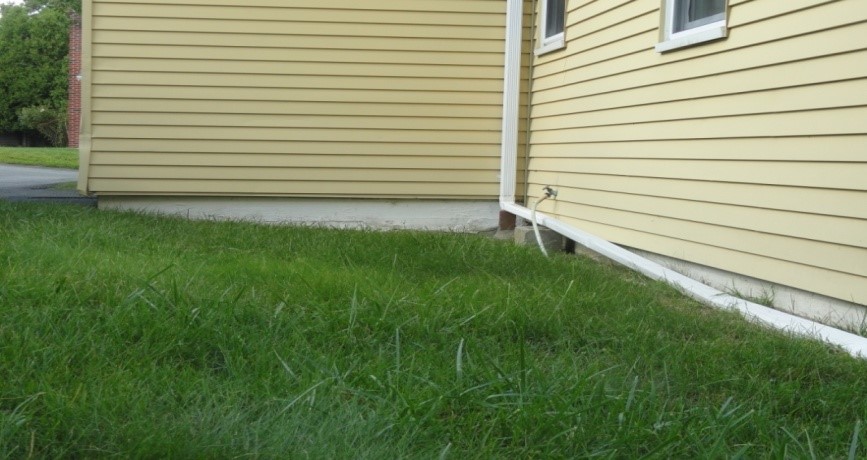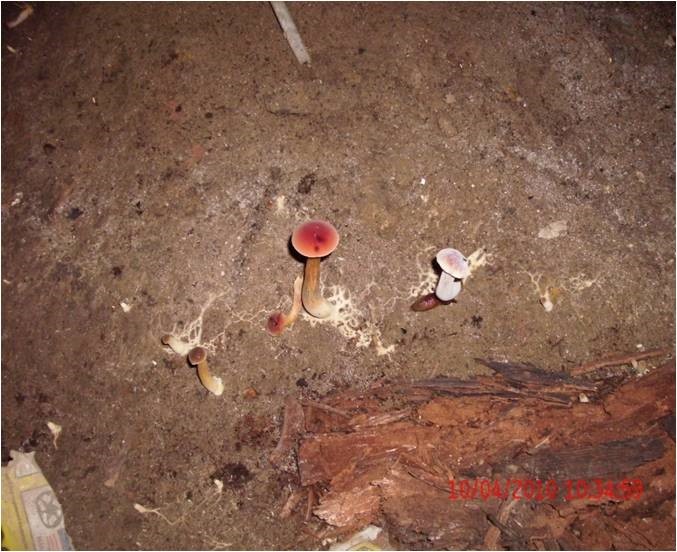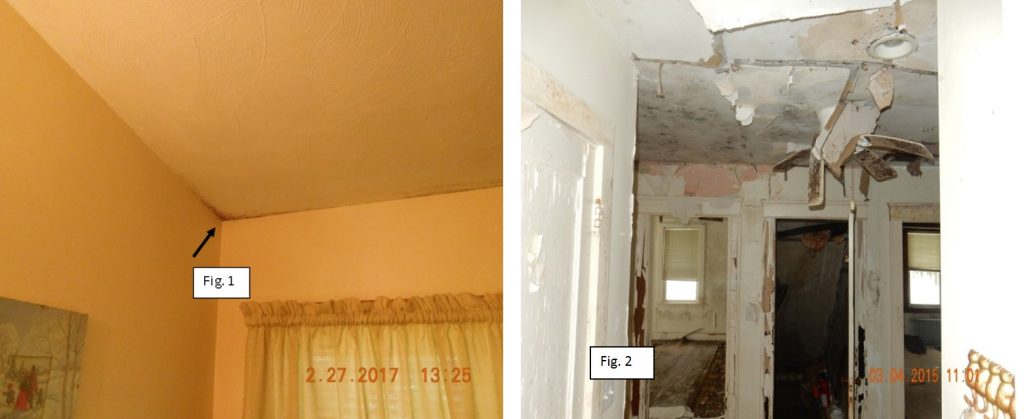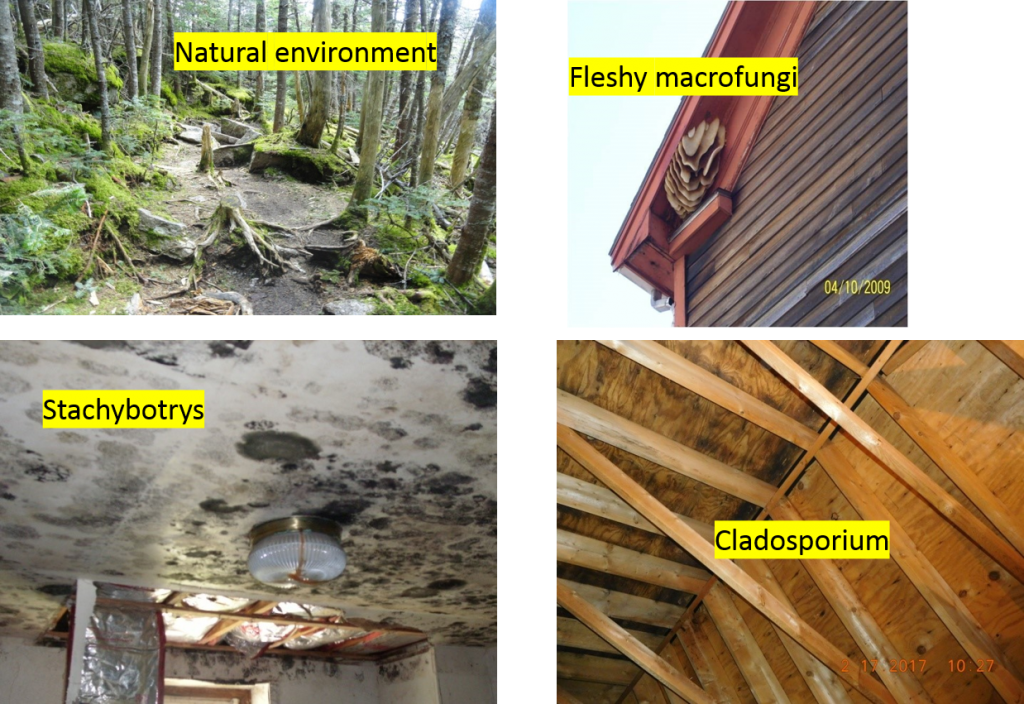
by Mike Quigley | Apr 7, 2017 | Blog
Keeping your basement dry is key to preventing mold growth. With all the rain we have been having here in Massachusetts, you may find that you have a problem with water in your basement.
When your house was built, the yard sloped away from the building, acting like the roof and drawing water away. After years of water dripping next to the foundation, the yard has sunk down next to the house and water is now directed towards the foundation.
One solution is to add new dirt and grass and build the ground cover back up o slope the yard away from the house. A good rule is one inch to the foot for 10’. Also, maintain 8”of minimum clearance from the dirt and the wood siding or trim to keep the wood from rotting and to keep termites out.
I actually prefer the 18”rule; 18” of clearance between the siding and the dirt or ground cover, 18” of clearance between the siding and fully grown shrubs, 18” of clearance between a finished basement wall and the foundation wall and an 18” of overhang at the soffits.
In some cases you may need to add a swale to control water. A swale is a water harvesting ditch or depression that is used to handle storm water runoff.
This yard in the picture slopes towards the home in every direction. You can see how water will be drawn directly into the basement.


by Mike Quigley | Apr 1, 2017 | Blog
Did you know that a 700 sq. ft. dirt basement can discharge up to 10 gallons of water a day? Even a concrete floored basement can discharge large quantities of water through simple evaporation. If you insulate the floor joists above this dirt floor, the insulation can absorb the water vapor and become soggy, presenting a condition that can lead to mold growth.
Excess water vapor trapped in a house can accumulate in the attic and may contribute to, or even cause an attic mold problem. Install a vapor barrier or concrete over the dirt floor. To help with prevention, remove any insulation from the ceiling over the dirt basement floor. You should also provide a heat source for the basement and keep humidity levels between 35% and 50%.


by Mike Quigley | Mar 14, 2017 | Blog
If you have a small amount of mold on your bathroom ceiling (as in fig. 1), you can probably handle it yourself. Use whatever you normally use for cleaning (except bleach). Spray it on and let the cleaner do the work. The typical dwell time, the time you should let it absorb into the sheet rock, is about ten minutes. You may need to spray it a few times. Then use a sponge with a scrubbing side to remove it. This may cause some damage to the surface of the sheet rock a little.
If you’re project is slightly bigger (as in fig. 2), you should probably let us handle it.

Why not use bleach? If you spray bleach overhead, it will fall back down into your eyes or face. When you are in the emergency room, having your eyes flushed out and the doctor asks you, “who told you to do that?” The answer better not be Google.
Below is information from the warning labels from two of the popular mold remediation products; MMR and GMP. Both are bleach based (Sodium Hypochlorite) Mold and Mildew Stain removers that some contractors are using in attics. These are not products that I recommend or use due their high toxicity. S
Note: Clorox bleach is a 5.25% solution of Sodium Hypochlorite mixed with water. MMR and GMP products are 7.00%. When the bleach evaporates, the water left over feeds the mold root system. This will actually eventually cause the mold spores to grow back, usually in larger numbers then what you started with.
The key thing to remember for either DIY or professional mold removal – no bleach based products.
PRODUCT NAME: MMR Mold and Mildew Stain Remover
MANUFACTURER: Healthy Home Solutions, LLC.
CHEMICAL FAMILY: Sodium Hypochlorite
Signal word: Danger
Hazard statement(s):
H315 – Causes skin irritation
H318 – Causes serious eye damage
H401 – Toxic to aquatic life
Harmful if swallowed
PRODUCT NAME: GMP Mold and Mildew Stain Remover
User Instructions: Not recommended for Household use.
CAUTION: Use appropriate precautions when using GMP Mold and Mildew Stain Remover. This is a commercial strength stain remover with chlorine like aroma that comes with an odor masking agent (fresh rain).
Product Use: This product is manufactured for Commercial/Industrial use.
Avoid contact with strong acids, releases Chlorine gas

by Mike Quigley | Mar 2, 2017 | Blog
Molds are part of the fungal kingdom, which also includes mushrooms, wood rots, and yeasts. There are two categories of fungi:
Fleshy macrofungi: This type of mold grows fruiting bodies which we call mushrooms or toadstools.
Powdery microfungi: This type of mold is normally referred to as mold or mildew which produces microscopic spores all along the surface of the fungal growth.
Mold spores are everywhere in the natural environment. They just lay there dormant waiting to be activated. They hide out in house dust. They get tracked in on shoes and get trapped in carpeting. They fly in on air currents. They are just searching for food. When they find food, which is anything biodegradable, they land on it and wait for a water source so they can start eating. If there is no water source forthcoming, they will go dormant or die of thirst. How do you activate the mold spores? Give them water. How do you deactivate them? Take the water away. It really is that simple, get rid of the water and you get rid of the mold.
Look outside your window. What do you see? You see mold growth everywhere on everything. Mold is in its natural environment. The main purpose of mold is to break down dead materials such as wood and fibers (substances used in building materials). It’s the BIO in biodegradable.
If mold is everywhere, then why isn’t it growing all over the inside of your house? It’s because your house is an artificial environment. You control the temperature and the humidity of your home. This is what I always tell my clients: “You don’t have a mold problem, you have a water problem.”
A common question about mold is, “Is it the black mold?” This is usually asked about attic mold. The mold in the attic may be black, but it rarely is the black mold. The mold that most people are concerned with is Stachybotrys. STACHYBOTRYS is typically associated with water damage. This is a slow growing, dark mold that grows well on cellulosic (paper-containing) building materials. It can produce a number of different macrocyclic trichothecenes which have been described as being toxic to humans and animals. Individuals with chronic exposure to the toxins produced by this mold report cold and flu-like symptoms, sore throats, headaches, fatigue, dermatitis, itching and burning sensations of the eyes and nose, and general malaise. This mold is rarely found in outdoor air samples, and it is usually not found in indoor air samples unless the colony is dry is then physically disturbed. This mold is common everywhere growing on soil and decaying plant material. Stachybotrys needs a high water content to grow.
So what type of mold is in your attic? If the mold growth is caused by water vapor as opposed to water leakage, the mold type is usually Cladosporium. Cladosporium is the most common spore type reported in the air worldwide. Outdoors it is found on dead and dying plant litter and soil. Indoors it is commonly found on wood and wallboard. It typically grows on window sills, textiles, and foods.


by Mike Quigley | Feb 22, 2017 | Blog
A new trend I’m seeing in attic mold removal is what I call the “hide-and-hope method.” As in hide the problem and hope the buyer’s home inspector doesn’t find it. I have been installing attic ventilation systems and removing mold from attics for more than 20 years and I am also a licensed home inspector. I can attest that whatever method of mold removal is used, there will always be a telltale sign that remediation was performed.
If a seller does not list the fact that mold remediation was performed on the property and the home inspector finds it, how will that make anyone in the transaction feel? As a real estate agent, you now have to go back to the buyer and tell them that the seller tried to pull a fast one. As the homeowner selling the property, you will always live with the knowledge that you passed along a potential problem to someone else without making him or her aware of it. The buyer now wonders that if the mold issue was not disclosed and an attempt to cover it up was made, what else about the property was not disclosed or covered up. The whole deal is then tainted and trust is broken. The hide-and-hope method is a huge chance to take, creates a red flag for the entire transaction, and I do not recommend it. The home inspection will actually go much better if any known problems and what may or not have been done to fix those problems are disclosed. Honesty is the best policy for all involved.
When Quigley Attic Mold performs attic mold remediation, we list what the original cause of the problem was (for example, bathroom fans venting into the attic, lack of proper ventilation, etc). We then fix the problems that led to the mold growth, and remove the mold. To insure that the mold has been completely removed, we finish each job with an antimicrobial sealant. The sealant is white and contains properties that inhibit new mold growth and makes it extremely easy to see that all mold and any residual stains have been removed. We then provide a transferrable warranty to the homeowner to pass along to the buyer. When the home inspector shows up, he or she can now put in the report that there was a problem caused by such-and-such that had resulted in mold growth. He or she can now note that the problem was addressed, the mold completely removed and the transferable warranty is in place. Instead of employing the hide-and-hope method, remember that the solve-and-share system works better for all involved in any real estate transaction.

by Mike Quigley | Feb 17, 2017 | Blog
The common problem: A client has excess humidity in the attic in the winter and excess heat in the summer. The client applies the logic that installing a fan will cool down the attic and remove the water vapor. This is an erroneous solution put forth by home improvement stores, as well as contractors and home inspectors who mean well but are not certified specialists.
So the question frequently posed to me by a homeowner is, “Should I, or should I not, install a gable vent exhaust fan in my attic?”
The answer is, almost never. In certain circumstances, where no other form of ventilation is feasible, I might consider it, but only after a complete evaluation of the home. The negative air pressure created by the fan can actually make the attic and house warmer, rather than cooler. The fan can draw warmer exhausting air down from the ridge upsetting natural air flow and causing the attic to get warmer. The fan can also pull air conditioned (cooler) air up from the living space causing the house to get warmer while removing the cooler air to the exterior. This causes the air conditioning system to run longer using more electricity, while the gable fan is running using, yup, even more electricity. How efficient or “green” is that? Not very.
Every home is different and requires an evaluation of the whole of its systems, rather than the parts. When your home was built and brand new it had a balanced system. Well-meaning homeowners may inadvertently upset that delicate balance in a number of ways. Adding more insulation, replacing the windows or upgrading the heating system can significantly alter the way a home operates. Unfortunately, the result of these good intentions is usually mold growth in the attic.





